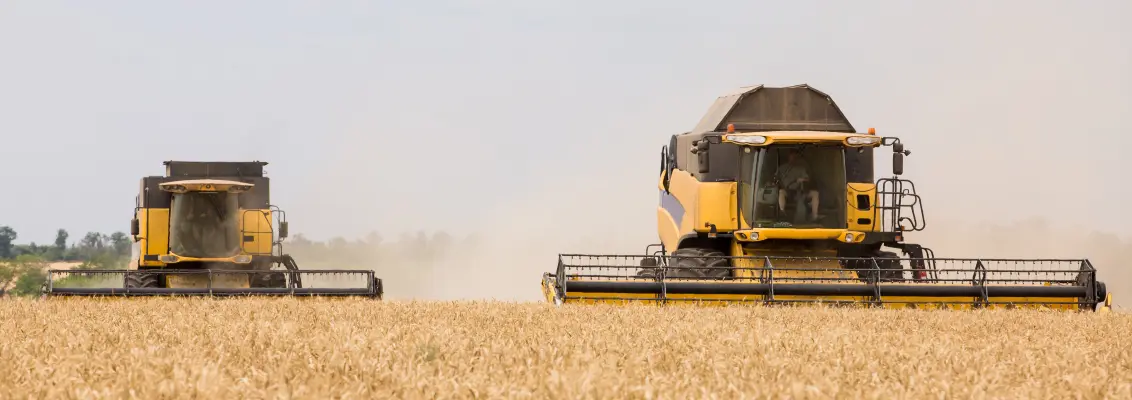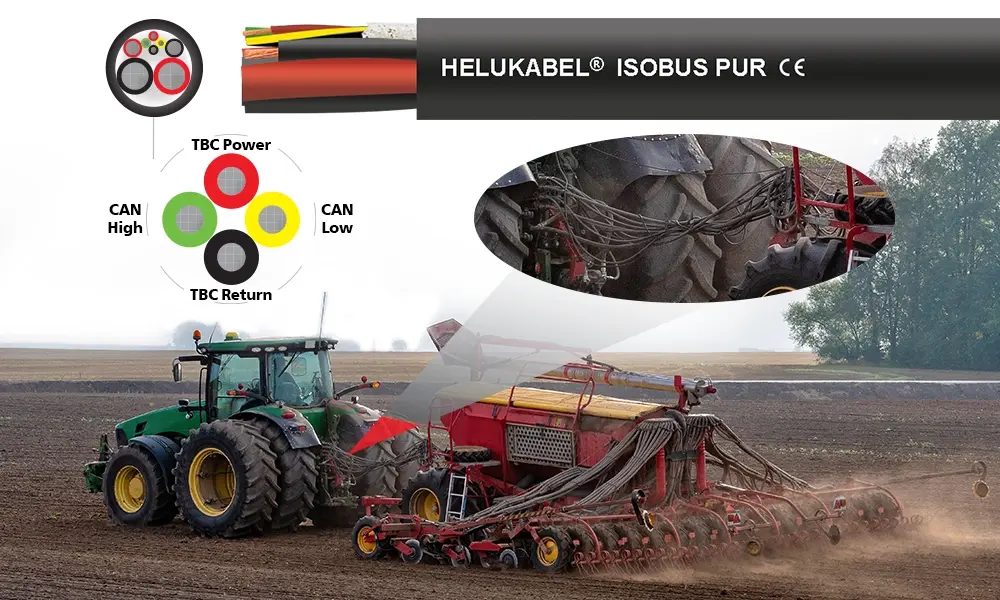Q&A With HELU: Cables for the Agriculture Industry

The importance of ensuring that farmers do not experience cable failures in their agricultural operations cannot be overstated. Cables and electrical wiring are the lifeblood of modern farming, as they power essential equipment such as irrigation systems, machinery, and monitoring devices critical for crop health and yield optimization. Cable failures can disrupt these vital functions, leading to potential crop loss, decreased productivity, and increased operational costs for the farmer. Moreover, in an era where precision agriculture and data-driven techniques are becoming increasingly prevalent, reliable cables are indispensable for the collection and transmission of real-time data, enabling farmers to make informed decisions and maximize resource efficiency. Therefore, preventing cable failures is not just a matter of convenience; it is a fundamental necessity for the sustainability and success of modern agriculture. In our latest Q&A With HELU, we look at some of the challenges and cable technology found in the agriculture market.
Q: What are the different types of cables used in agriculture?
A: Various types of cables are employed in agriculture to facilitate and enhance farming operations. These cables play a crucial role in powering equipment, collecting data, and ensuring efficient communication within the agricultural environment. Some common types of cables used in agriculture include:
Power Cables: Essential for supplying electricity to agricultural machinery, irrigation systems, and other equipment. They ensure that tractors, pumps, and other energy-dependent devices operate effectively. With equipment needing increasing levels of power, high-quality cables are essential for a long service life.
Control Cables: Control cables are used in precision equipment such as automated planters, harvesters, and grain handling systems. They enable precise control over machinery functions, optimizing seed placement and harvesting operations.
Sensor Cables: In the era of precision agriculture, sensor cables are instrumental in collecting data from various monitoring devices, such as soil moisture sensors, weather stations, and livestock tracking systems. This data provides farmers with insights into soil conditions, weather patterns, and animal behavior, enabling informed decision-making.
Communication Cables: In modern agriculture, communication is key. Fiber optic and Ethernet cables are used for transmitting data between different farm equipment and central control systems. Bus systems such as ISOBUS, CAN-Bus, and the agricultural version of Single Pair Ethernet (SPE) known as High Speed ISOBUS (HSI) are also being used. These cables support remote monitoring and control, allowing farmers to manage their operations efficiently.
Irrigation Cables: These specialized cables are designed to withstand moisture and underground conditions, making them ideal for connecting irrigation systems. They help control water distribution, ensuring crops receive the right amount of moisture, which is vital for crop growth and yield.
Livestock Containment Cables: Electric fencing systems rely on specialized cables to deliver electric pulses to keep livestock within designated areas. These cables are essential for animal containment and pasture management.
Q: What environmental hazards do cables used in agriculture face, and how can they be mitigated?
A: Cables used in agriculture are exposed to a range of environmental hazards, which can impact their performance and longevity. These hazards include moisture and water exposure, UV radiation, mechanical stress from the frequent moving, bending, and flexing of agricultural machinery and equipment, chemical exposure from the use of fertilizers, pesticides, and other chemicals, as well as extreme temperature fluctuations based on where the farm is located.
By addressing these environmental hazards using the proper industrial cables and proper cable management, while also taking preventive measures i.e., routine maintenance, farmers can ensure the longevity and reliability of the cables in their agricultural operations, which ultimately reduces downtime and increases overall farm efficiency.
Q: Which organizations are responsible for ensuring cable safety and compliance with industry standards?
A: The approval and regulation of cables used in agriculture involve a combination of government agencies and industry standards organizations. Some of the key regulatory bodies are the National Electric Code (NEC) published by the National Fire Protection Association (NFPA), Underwriters Laboratories (UL), the European Committee for Electrotechnical Standardization (CENELEC), and the International Electrotechnical Commission (IEC). The Agricultural Industry Electronics Foundation (AEF), which HELUKABEL is an active member of, is an independent organization that encourages the development and implementation of new technology while working to improve cross-manufacturer compatibility of electronic and electric components in agricultural equipment.

In addition to the power conductors, ISOBUS cables are constructed in a so-called star quad formation with 1 x 4 x AWG 20 (0.5 mm²). This structure is crucial for reliable data communication between the tractor and implement.
Q: What is ISOBUS and what benefits does it bring to the agriculture industry?
A: ISOBUS is a standardized communication protocol widely used in the agricultural industry. It enables seamless communication and data exchange between different agricultural machinery and implements, regardless of the manufacturer. ISOBUS cables combine power and data transmission into one cable and provides farmers with a multitude of advantages to their operations. Some of these advantages include:
Standardized Communication: ISOBUS serves as a universal language for agricultural equipment. It allows tractors, harvesters, planters, and other farm machinery to communicate and share data easily, enhancing interoperability on the farm.
Simplified Operation, Increased Efficiency: Farmers can use a single terminal or display to control various ISOBUS-compliant implements. This streamlines the operation of complex farming equipment and reduces the need for multiple control panels. This allows equipment can be quickly and accurately configured, reducing setup time and minimizing errors during fieldwork.
Enhanced Precision Agriculture with Data Management: ISOBUS facilitates the integration of precision agriculture technologies. It enables real-time data exchange, such as GPS positioning, soil and yield monitoring, and variable rate application, which optimizes crop management and resource utilization. The collection and transfer of information allows farmers to make data-driven decisions for better crop management and yield optimization.
Future-Proofing: ISOBUS can adapt to new capabilities and requirements as technology advances. This future-proofing ensures that agricultural machinery can remain compatible with evolving precision agriculture tools and software.
Cost Savings: ISOBUS reduces the need for proprietary connections and interfaces, saving farmers money on specialized equipment and making it easier to switch between different equipment brands. Additionally, with the increased level of sensor data from the implements, farmers reduce material costs by applying only the required seed and fertilizer to produce the maximum yield.
Q: Are there any new cable technologies in the agriculture sector?
A: As agricultural machinery is becoming more and more electrified higher data speeds and more power are being required. Two technological areas are currently being worked on: High Speed ISOBUS (HSI) and medium-voltage power (MV).
High Speed ISOBUS (HSI) is an advanced communication protocol that will be used in modern agricultural machinery in the future to enable seamless data exchange and control between different implements and tractors. The new HSI data transmission is based on Single Pair Ethernet (SPE) 1000Base-T1 providing faster data transfer rates – up to 4,0000 times faster, which enhances the efficiency and responsiveness of communication between devices. To ensure machines stay in the field, more monitoring is required through the use of cameras and even more sensors. The increased data speed allows for more rapid and accurate control of equipment in real-time, leading to improved precision farming practices.
The AEF’s medium-voltage (MV) project team is working on a new standard based on a DC system with higher voltages of around 48 V DC. The previously used 12 V DC system is no longer sufficient to support the increased use of electrical drives appearing on modern agricultural equipment.
ARTICLE DOWNLOAD
Click here to view this article in our digital download center.
